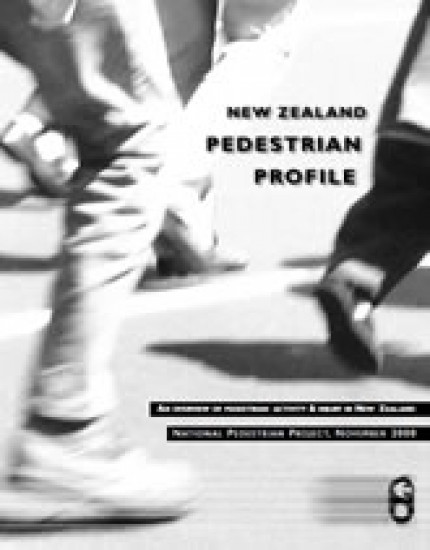This profile aims to make visible the extent and importance of pedestrian activity and injury in New Zealand. Its focus is on walking as a transport mode, and it aims to provide an accessible overview to those who plan our communities and manage our roads.

When we get out of our cars we are all pedestrians.
1. Walking is the glue that binds our urban transport systems together. It is not only an essential transport mode for those with limited access to a motor vehicle, and an integral component of most public transport trips, but also an important part of many motor vehicle journeys. A survey of regional household travel in the Auckland region found that 36% of travel journeys combined motor vehicle use with pedestrian activity.
2. Walking is a sustainable, efficient and economical mode for short journeys. As a nation, around 46% of our household travel trips are estimated to be for distances of under two kilometres. The sustainability of our transport system depends not only on increasing the efficient use of the transport network by motorised traffic for long journeys, but also increasing the use of non-motorised modes such as walking for short trips, particularly in our urban areas.
3. Walking has considerable economic, health & social benefits. It provides valuable cardiovascular exercise for individuals, enhances the liveliness of communities, supplies the ‘foot traffic’ that is essential to local businesses, provides the ‘eyes on the street’ that help keep our neighbourhoods safe, and enables older members of the community to remain socially connected.
Nearly one in five of our travel trips is undertaken on foot.
1. Walking makes up a significant proportion of the travel of New Zealanders. According to the New Zealand Travel Survey (1997/98), of the more than 6 billion trips estimated as being undertaken by New Zealand households annually, 1.1 billion (18.7%, or nearly one in five) are undertaken on foot. Walking accounts for seven times as many trips as public transport, 10 times as many trips as cycling.
2. Walking is particularly significant in the travel of children and young people, and older adults. Women, Pacific peoples and Maori tend to spend more time walking, as do people at the top and bottom of the economic spectrum, and those living in urban areas.
3. Around 70% of walking trips involve walking as the sole mode of transport used to get to a destination. However, around 30% occur as part of ‘multi-mode’ journeys involving other modes of transport (e.g. public transport).
4. We walk for a wide variety of purposes — social/leisure trips are most common, followed by shopping trips, then education and work trips.
5. Walking is on the decline.The percentage of our travel journeys in which walking was the sole mode of transport dropped 3% between 1989/90 and 1997/98. This equates to approximately 400,000 fewer ‘walk only’ trips being undertaken by New Zealanders each day. Most of these trips are now being undertaken in private motor vehicles.
Pedestrians account for one in four deaths on our urban roads.
1. Pedestrians account for one in nine road deaths nationally, one in four deaths (28%) on our urban roads.
2. The social cost of road crashes involving pedestrians is significant — an estimated $290 million annually.
3. Children are at greatest risk of pedestrian injury, followed by older adults and young people. Pacific peoples are at greater risk than Maori, who in turn are at greater risk than Pakeha.
4. The vast majority (92%) of pedestrian injuries occur on urban roads, especially the relatively busy roads that bisect our suburbs and urban communities. More than half occur on ‘arterials’, and a quarter on ‘distributors/collectors’. Only one in five occur on streets designated as ‘local roads’ by territorial authorities.
5. The majority of injured pedestrians are struck while crossing the road, away from intersections and pedestrian crossings, and within two kilometres of home. More than 60% of those hospitalised because of their injuries live in the three regions with the largest urban populations - Auckland, Wellington and Canterbury.
6. Recent trends show poor progress on improving pedestrian safety compared to other road user groups. On roads with speed limits of 50 km/ph or less — the roads on which the majority of pedestrian crashes occur — pedestrian fatalities have risen from 29% of road fatalities (1994-1996) to account for 36% of all road fatalities (1997-1999).
7. For children, those who continue to walk may be at increasing risk of injury. When comparing the five year period 1993-1997 with the five years previous, there was no progress achieved in reducing New Zealand's rate of child pedestrian hospitalisation per head of population — even though children's walking activity declined by 10% over the period. Children living in the Auckland region have a particularly high rate of hospitalisation per head of population, and this rate appears to be rising.
1. Walking will not simply take care of itself as a transport mode. For pedestrian activity to remain viable and safe, pedestrian issues must be better considered in our urban planning, and walking better integrated into our transport research and planning, road management and road safety decision making.
2. For walking to be a transport mode of choice, ‘walkable communities’ are required — communities with safe, direct and pleasant walking environments, and destinations within walking distance.
3. This may require a shift in the way we approach pedestrian safety — from simply looking at reducing pedestrian crashes, to a focus on providing pedestrians with safe mobility in and around their local communities.
4. Creating walkable road environments is cost effective in comparison to other transport modes. For less than the cost of building a single kilometre of motorway, it is possible to achieve a safe, direct and pleasant road environment for pedestrians within an existing urban community of 50,000 people. The resulting road environment will benefit not only pedestrians, but other road user groups such as cyclists and public transport users, as well as road safety.